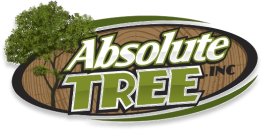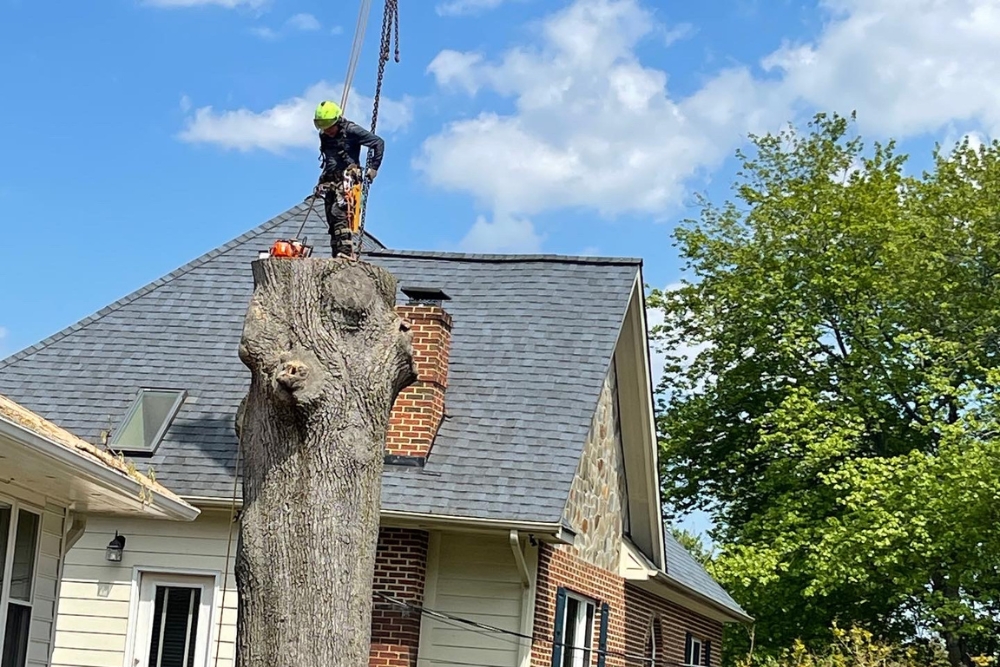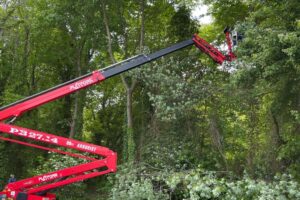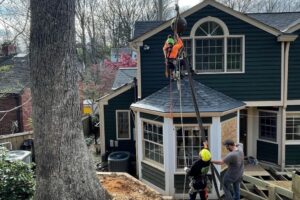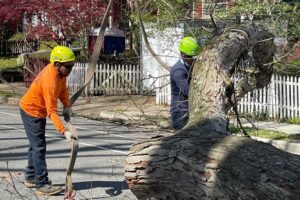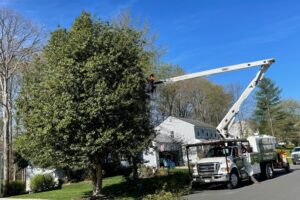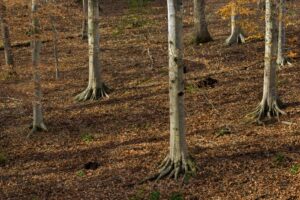Woodpeckers are an essential part of the Northern Virginia ecosystem, but they can be a nuisance if they begin targeting your trees. The trademark “tap-tap-tap-tap” of a woodpecker hammering on a tree will give you a headache as you think about the holes they’re drilling into your trees. Thankfully, there are ways to prevent woodpecker damage if you notice increased activity.
In this article, we will examine why woodpeckers hammer on trees and six prevention methods for discouraging them. We also have a few techniques for repairing your trees after woodpecker damage and a guide to typical species to watch out for in northern Virginia.
Key Takeaways
- Woodpeckers hammer on trees in search of insects and sap, to build homes in dead trees, or to attract mates.
- The best way to prevent woodpecker damage on your trees is by eliminating the boring insects in the trees.
- Hang reflective surfaces, such as CDs or mirrors, from trees to scare away woodpeckers. Tests show this is the best deterrent outside of removing insects.
- Other methods for preventing woodpecker damage include wrapping the tree in burlap, placing plastic predators, and making loud noises to scare the birds.
- Harming woodpeckers is against federal law – don’t do it!
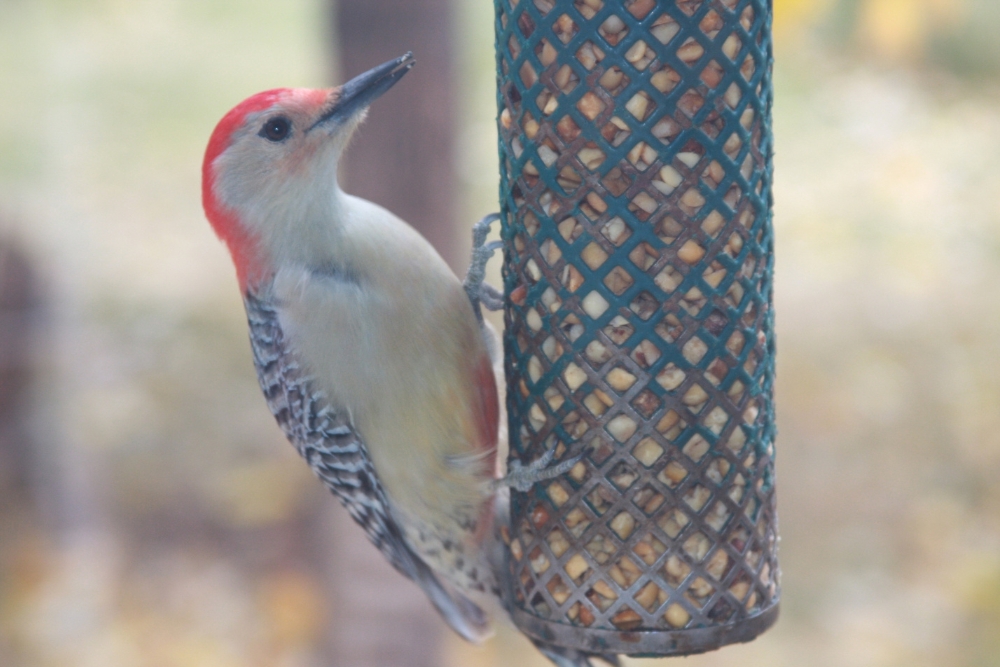
The red-bellied woodpecker is one of seven native woodpeckers in northern Virginia. Photo courtesy of Steven Katovich, Bugwood.org.
Why Woodpeckers Drill Holes in Your Trees
Woodpeckers hammer on trees for numerous reasons, including:
- Searching for insects: If a woodpecker detects insects under the tree’s bark, it will poke small holes in search of them. They primarily feed on larvae but will eat almost all insects. Woodpeckers may hear the insects under the bark or notice the holes left by boring insects to identify what tree to hammer.
- Searching for sap: Some woodpeckers, most notably the yellow-bellied sapsucker in Northern Virginia, also feed on tree sap. They drill tiny holes in trees to encourage sap production, similar to tapping a maple tree to gather sap for maple syrup.
- Building a home: If a woodpecker notices a dead or dying tree, it may begin drilling into it to hollow out a cavity to serve as its nest. It may also attempt to build a nest in houses with natural wood exteriors.
- Attracting mates: The hammering of a woodpecker doesn’t just catch your attention; it also helps attract mates. You may notice more hammering in spring, even on healthy trees with little insect activity (as well as anything that makes a loud noise when hit by a woodpecker’s beak, including stop signs!). Once the woodpecker finds a mate, it will generally stop hammering.
Why Woodpeckers Drill Holes in Your Trees
Woodpeckers hammer on trees for numerous reasons, including:
- Searching for insects: If a woodpecker detects insects under the tree’s bark, it will poke small holes in search of them. They primarily feed on larvae but will eat almost all insects. Woodpeckers may hear the insects under the bark or notice the holes left by boring insects to identify what tree to hammer.
- Searching for sap: Some woodpeckers, most notably the yellow-bellied sapsucker in Northern Virginia, also feed on tree sap. They drill tiny holes in trees to encourage sap production, similar to tapping a maple tree to gather sap for maple syrup.
- Building a home: If a woodpecker notices a dead or dying tree, it may begin drilling into it to hollow out a cavity to serve as its nest. It may also attempt to build a nest in houses with natural wood exteriors.
- Attracting mates: The hammering of a woodpecker doesn’t just catch your attention; it also helps attract mates. You may notice more hammering in spring, even on healthy trees with little insect activity (as well as anything that makes a loud noise when hit by a woodpecker’s beak, including stop signs!). Once the woodpecker finds a mate, it will generally stop hammering.
Ways to Prevent Woodpecker Damage to Your Trees
There are no perfect methods to prevent woodpecker damage, but our suggestions will at least help curtail woodpecker activity in the short term. Woodpeckers can be stubborn and unwilling to leave a tree alone, so you must be persistent and consistent in your efforts to deter them from hammering on your trees.
PRO TIP: Your trees can generally survive typical woodpecker damage. You may only need to take action if woodpecker activity becomes too extreme and puts your trees in danger of severe damage or at risk of attracting disease-carrying insects.
Reducing the Insect Population in Your Trees Will Discourage Woodpecker Activity
The most effective way to deter woodpecker hammering is to fix the underlying issue of insects beneath the bark. Unfortunately, this is also the most time-consuming solution. If an arborist inspection reveals a boring insect infestation, responsible use of an appropriate insecticide to kill the larvae should curtail woodpecker interest in your tree.
If insecticides aren’t the answer, an arborist may implement other facets of Integrated Pest Management (IPM), such as introducing beneficial insects or suggesting cultural practices for you to follow to lower the insect population.
Use Reflective Surfaces to Scare Away Woodpeckers
A 2007 study of common deterrents found hanging reflective surfaces on trees to be the most effective deterrent for woodpeckers. The test concluded there is no perfect solution to woodpecker damage, but reflective surfaces and streamers have the best success rate.
The reflective surface of these streamers and their movement from the wind scares the birds away. In half of the test sites, these deterrents eliminated woodpecker damage.
Though this test only looked at reflective streamers, many homeowners in Northern Virginia have reported success using other shiny, reflective surfaces such as helium balloons, pinwheels, reflective tape, or old CDs (if you happen to still have any lying around).
Consider Purchasing Replica Predators to Discourage Woodpeckers
Replicas of common Northern Virginia predators, such as a plastic owl or hawk, may temporarily discourage woodpeckers from hammering on your trees. However, the birds will eventually realize the predators aren’t real and ignore them.
You could use these faux predators to buy time for your trees while you schedule a tree health evaluation to determine if there are any underlying problems attracting woodpeckers to your trees.
Place Netting or Burlap Over Your Tree to Limit Woodpecker Access
Woodpeckers can’t hammer your trees if they can’t get to them. Wrapping part of your tree with bird netting or burlap will discourage woodpeckers from trying to drill into the tree. The netting should be about three inches from the bark surface and pulled taut. You can also use aluminum foil and wrap it around the tree.
Think of these physical barriers as a shield for your tree. With enough determination (and believe us, some woodpeckers are very determined), they can get around it and continue drilling into trees. Still, many will judge it as not worth the effort and look for easier pickings elsewhere.
While physical barriers are effective in curtailing woodpecker activity, they have a few obvious drawbacks. Besides the unattractive look of tinfoil or netting-covered trees, there’s the issue of how to install these protective covers in the first place. It’s usually not feasible to put up these barricades on large trees or higher in the tree canopy.
Consistent Noise Can Deter Woodpeckers
If you notice a woodpecker banging on a tree in your yard, make loud noises by yelling or banging pots together to scare them away. They may return after the initial commotion, so practice consistent
deterrence to keep them away. Granted, this isn’t a good method to use in neighborhoods with neighbors nearby and very few people are willing to keep watch all day with pots at the ready…
Remove the Tree if the Woodpecker Damage is Too Extreme
In extreme cases, woodpecker damage can kill a tree, turning it into a prime target as a woodpecker nesting site. Removing the tree isn’t a decision to take lightly. If the tree does not pose an immediate danger to your property or family, consider leaving it up to provide a home for wildlife (yes, that includes woodpeckers!).
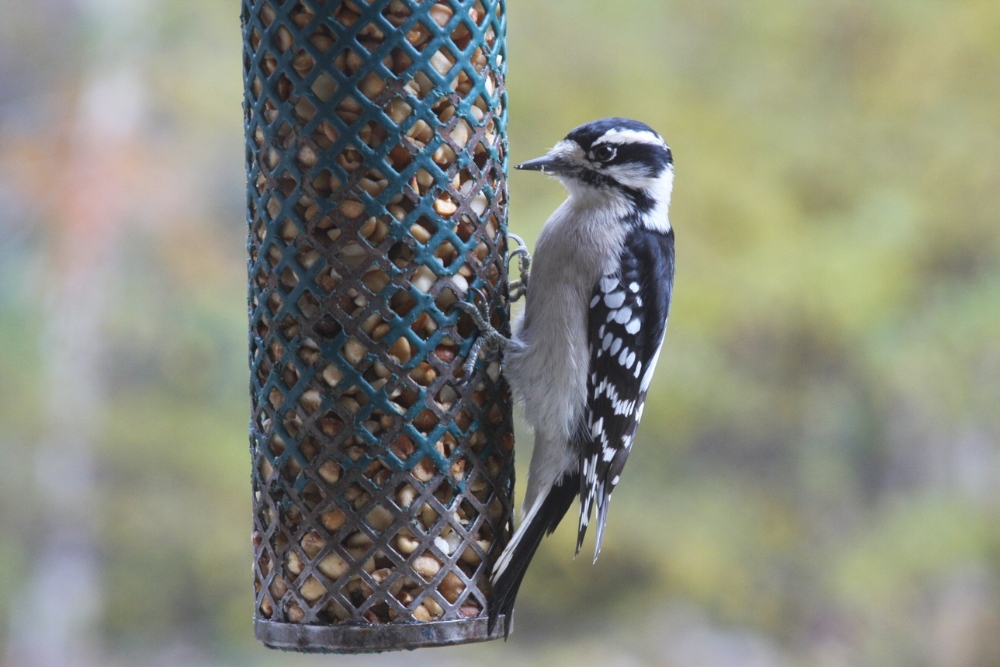
The downy woodpecker, a Virginia native. Photo courtesy of Steven Katovich, Bugwood.org.
Woodpeckers Have Protections: Don’t Harm Them
Over the years, customers from Arlington to Fairfax Station have asked us what to do about woodpeckers hammering on their trees, including asking if it is okay to trap them. While it may seem like a good solution, it is illegal to harm woodpeckers.
WARNING: Woodpeckers, like many non-game birds in the United States, have protections under the Migratory Bird Treaty Act of 1918. It was enacted to protect birds from over-hunting, which was prevalent at the turn of the 20th century. All Northern Virginian woodpeckers fall under this act’s protection.
In cases of extreme attacks and problems from woodpeckers, you can file for a permit from the federal government to trap or hunt woodpeckers in limited numbers.
We’ve also had Northern Virginia customers consider covering trees with a sticky deterrent to discourage woodpeckers from pecking trees. While this may sound like a reasonable and non-lethal solution, some ornithologists have warned against it. The repellent can end up in a bird’s plumage, making it difficult for the woodpecker to fly or stay warm.
Repairing a Tree After It Sustains Woodpecker Damage
For most minor damage, a tree will heal without human intervention. More serious damage may require an arborist assessment.
For example, extensive woodpecker activity may cause tree girdling (damage to the bark around the entire circumference of the tree, preventing nutrient and water transport to the canopy) or introduce fungal pathogens through the holes it makes in the bark. An arborist may recommend a preventive fungicide treatment or supplemental fertilization to help the tree recover.
Woodpeckers Aren’t All Bad
Before you try any of our prevention methods, remember that woodpeckers are often beneficial to your trees as they eat pests and help you more quickly identify insect infestations.
Woodpeckers may also help in the fight against invasive species like the emerald ash borer (EAB), according to reports from the U.S. Department of Agriculture.
Absolute Tree Service Can Help You Prevent Woodpecker Damage
Woodpeckers often point out underlying issues and pest infestations with your trees. Curing the underlying problem and removing pests from trees will help limit the woodpecker activity in your yard. You can also attempt to scare the birds away with reflective streamers or old CDs while you try to remedy the underlying problem.
If the woodpeckers are telling you something is amiss with your trees, the team at Absolute Tree Service can help. We will examine your trees, determine if there are pests or if the tree is dying, and then suggest a plan to rectify the situation. We may begin with an insecticide treatment to remove the problem or plan to remove a dead and dangerous tree.
Time is of the essence when it comes to insect infestations. Call us at 703-969-6207 or request an estimate online to start the process of identifying and removing woodpecker problems.
For the Absolute Best Tree Service in Northern Virginia, call Absolute Tree Today!
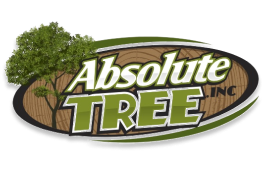
Author Profile: Ashley Davis
Over the last 19 years, Absolute Tree has grown a reputation as one of the premier tree service companies in the Northern Virginia areas. And there’s a good reason for this—we love trees and our passion for them shows. When you call on Absolute Tree for tree service, you aren’t just getting “some guys who cut down trees.” You’re hiring highly skilled arborists who understand the growth of trees and consider tree care an art form.
Stay Up-to-date!
Swing in each month for new articles, pest alerts, local resources, tree care tips, tree health updates, and landscape maintenance ideas
